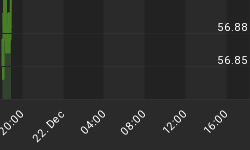The Long-Term Dollar Bear
A point we've made a few times in the past is that bear markets in the US$ tend not to end until after the US current account has moved into surplus. In other words, once a US$ bear market is set in motion it will continue until the quarterly current account deficit has been eliminated. The latest bear market in the US$ has been underway for about 2.5 years. And, since the current account deficit is still hitting all-time highs almost every quarter there is a very high probability that this bear market is still in its infancy.
We can get some sense of where we are in the dollar's current bear market by looking at a long-term chart of the US$ relative to the Swiss Franc (SF). The below chart not only illustrates the SF's long-term uptrend relative to the US$ (the trend is defined by the upward-sloping channel), it also shows how the US$/SF exchange rate experiences multi-year bull and bear markets within the overall confines of the long-term channel. In fact, the oscillations between the long-term channel top and the channel bottom have been remarkably consistent in that each of the two SF bear markets (US$ bull markets) that occurred since 1971 lasted 6 years while each of the two SF bull markets (US$ bear markets) lasted 8-10 years. If this pattern continues then the US$ is presently 2.5 years into a bear market that will last a total of at least 8 years. Given that the US current account deficit has not yet even begun its corrective process, a further 5-6 years of bear market action in the US$ does not seem unreasonable.
 >
>Based on the historical pattern, the SF will reach its long-term channel top some time in the 2008-2010 period. And in order for it do so it will need to appreciate by about 50% from its current level over the next 5-7 years.
The Money Supply and War
As far as the financial establishment is concerned it is not just desirable that the total supply of money always expand, it is an absolute necessity. In fact, the current monetary system cannot continue to function unless the supply of money continues to grow. This is because almost all money is borrowed into existence, that is, it is created out of thin air when loans are made. A consequence of this is that every new dollar (or euro or yen or peso) brings with it a liability in excess of one dollar due to the obligation to pay interest. This, in turn, means that there is never enough money in existence to pay off all current debts. So, the total supply of money must continue to grow at a fast enough pace to enable the majority of borrowers to get their hands on enough money to at least pay the interest on their debts. If the money supply contracted for more than a brief period of time the system would collapse.
Below is a chart showing, in red, the year-over-year change in the total supply of US dollars (M3). While the M3 growth rate is still reasonably healthy by historical standards, it has plunged over the past 15 months. Furthermore, if the trend in money supply growth illustrated on this chart continues for another year then the money supply will start to contract (the US will experience genuine deflation).

The US Government and its central bank can be expected to do everything in their power to prevent the current trend from persisting. As explained above, they have no choice in the matter if they want the current monetary system to survive for a while longer.
Over the past two hundred years there have been three major strategies regularly used by governments, including the US Government, to reverse downward trends in money supply growth. These are a) increase spending on public works; b) cut taxes; c) go to war. Over the past 10 years the Japanese Government has concentrated totally on strategy a), whereas over the past 2 years the US Government has already tried strategies a), b), and, it could be argued, c).
Some people have recently hypothesised that the US' invasion of Iraq was not the result of genuine security concerns, but rather the result of a plan to prevent oil from being traded in euros. However, if you really believe there must be an ulterior motive for the war the above chart provides a far more plausible one than the recently discussed oil-euro-dollar link.
The war against Iraq may or may not be the result of genuine security concerns on the part of Bush and Blair, but either way it is not coincidental that wars often happen after the money supply growth rate has dropped to levels that are considered to be dangerously low. It seems that opportunities to go to war are 'jumped at' when the money supply growth rate is low whereas peaceful solutions will tend to be more vigorously sought during those periods when credit is expanding at 'healthy' clip.















